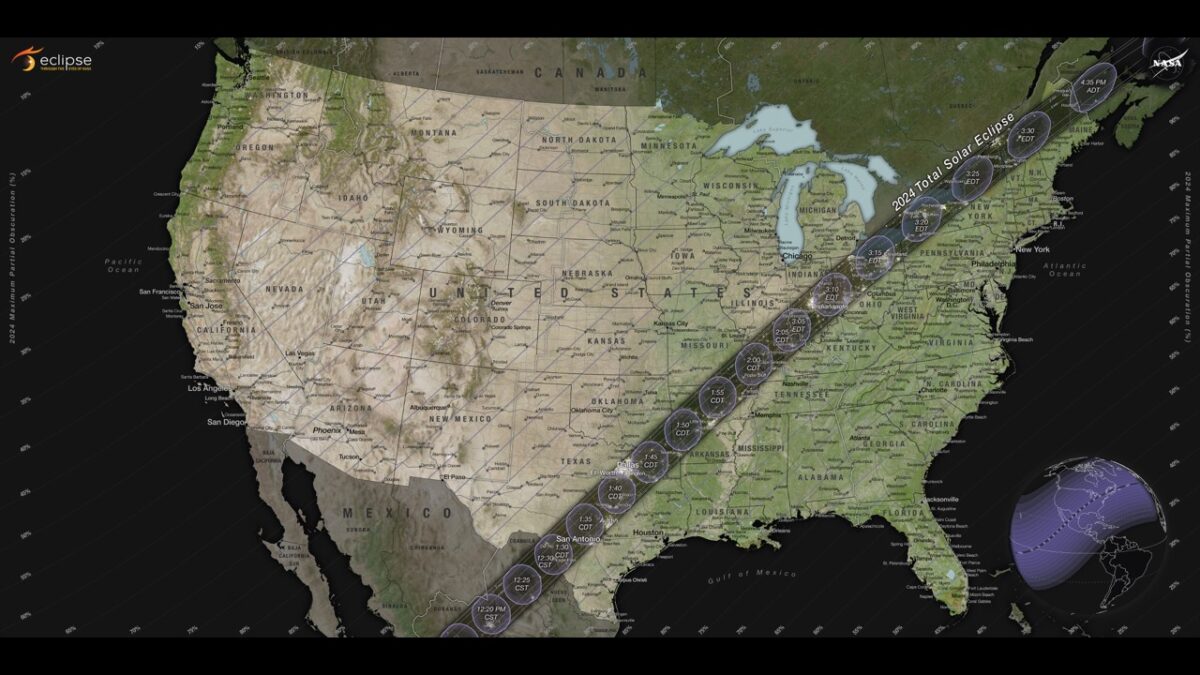On April 8, 2024, a solar eclipse will start on Mexico’s Pacific coast around 11:07 a.m. PDT, traveling across parts of the U.S. and Canada until 5:19 p.m. EDT. Because the sky will darken completely in the path of totality for up to six minutes, forecasters are looking at the potential effect on solar energy generation.
The last eclipse took place in the U.S. in 2017, and didn’t have much effect on solar energy production, however, solar contributed only 1.3% to the electrical grid at that time, according to the U.S. Energy Information Administration (EIA). The EIA estimates that solar will provide 6% of U.S. electricity generation this year—a significant increase over 2017, and enough to cause some concern about the eclipse effect.
Solcast, a solar modeling and forecasting company owned by DNV, reported that the impact on solar generation across the U.S. could be greater than any previous eclipse due to the increased solar power generation.
Solcast used its clear-sky irradiance modeling, assuming no presence of clouds or smoke. Due to ongoing growth in national solar capacity, the grid impact of such major solar events is increasing, and this eclipse will have greater impact on power generation than previous eclipses. The company forecasts that the overall effects of the eclipse will cost as much as 16% of daily total clear sky irradiance in some areas.
Grid operators are preparing for a worst-case scenario, which would be a perfectly sunny day when solar would normally be feeding steadily into the grid. In areas of in the path of totality, solar generation will decrease and then be cut to zero, only to ramp back up again a few minutes later.
According to Solcast, the maximum duration will be over 90 minutes of impacted generation and a total loss of up to six minutes. The effect across the country will be a faster “ramp rate” than normal, which is the rate at which solar generation decreases and then picks back up again.
Across all grids, Solcast estimates calculated maximum losses are up to 39.9 GWh, of which 16.2 GWh will be lost from household rooftop solar. “Whilst it’s too early to predict cloud impacts, the effects of this eclipse will be significant on solar generation across the country,” said Dr. Hugh Cutcher, lead Data Scientist at Solcast.
To compensate for potential loss of solar energy flowing to the grid, grid operators will have to be ready to rely on other sources to ensure grid stability, as was done during the 2017 and 2023 eclipse episodes.
Texas utility ERCOT, for example, is watching the event, as it provides power to 90% of the state and the state’s grid will be affected by the eclipse from 12:10 p.m. to 3:10 p.m. CDT, or during peak production hours. According to Solcast, ERCOT could experience a loss of nearly 11% of normal generation.
ERCOT posted on X that it is “working on forecasting models to reflect reduced solar power production (similar to a sunset and sunrise in the middle of the day) and does not expect any grid reliability concerns during the eclipse.”
Learning from the past
Looking back at the 2017 eclipse that obscured the sun for 76% of Northern California and 62% of Southern California on August 17, the EIA had estimated that more than 21 GW of installed photovoltaic (PV) systems would be affected. Utilities expected that production from solar plants would fall nearly 66%, with a sharp down ramp followed by an accelerated up ramp. To reduce “strain” on the electric grid, the California Public Utilities Commission President at the time urged residents to cut energy use between 9 a.m. and 11 a.m. on that day.
Because the ramping down and up had little deleterious effect, a call to curb electrical use is not likely to happen with the 2024 eclipse. In fact, during the 2017 eclipse, which also affected Georgia, Georgia Power “registered barely a blip”. Georgia Power had livestreamed the eclipse and watched solar power dip significantly for the three minutes of the eclipse’s totality and yet there was no failure to the grid.
This content is protected by copyright and may not be reused. If you want to cooperate with us and would like to reuse some of our content, please contact: editors@pv-magazine.com.









By submitting this form you agree to pv magazine using your data for the purposes of publishing your comment.
Your personal data will only be disclosed or otherwise transmitted to third parties for the purposes of spam filtering or if this is necessary for technical maintenance of the website. Any other transfer to third parties will not take place unless this is justified on the basis of applicable data protection regulations or if pv magazine is legally obliged to do so.
You may revoke this consent at any time with effect for the future, in which case your personal data will be deleted immediately. Otherwise, your data will be deleted if pv magazine has processed your request or the purpose of data storage is fulfilled.
Further information on data privacy can be found in our Data Protection Policy.